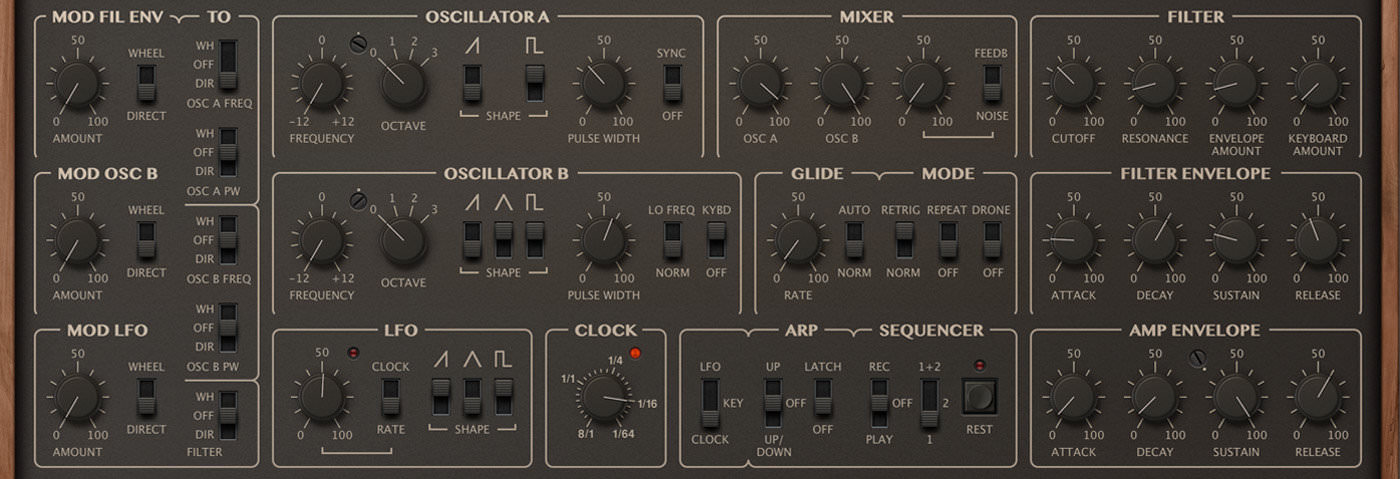
u-he are makers of award-winning software synthesisers and effects including Diva, Repro-1, Zebra2, Hive, Bazille, Presswerk and Satin.
Visit U-he

u-he are makers of award-winning software synthesisers and effects including Diva, Repro-1, Zebra2, Hive, Bazille, Presswerk and Satin.
Visit U-heSynth Secrets is a series of programming tutorials in which we show how to make a range of classic and new synth sounds using plugins such as Massive, Sylenth and Diva.
In this instalment of Synth Secrets we’ll be creating a house bass sound using U-He‘s analogue modelling synth Repro-1:
Audio PlayerLet’s start by opening up Repro-1. The sound it initialises with is a perfect starting point, so before changing it we’re going to go ahead and record the bassline in MIDI:
Audio PlayerNotice how the notes are clustered together rhythmically and melodically. The sequence is simple but what makes it move is the variation in the length of the notes. They start longer, which will create a bigger impact sonically, but become shorter at the end of the phrase, which allows more space for the kick but also gives them a bounce. The notes are also only a semitone apart each side which emphasises the groove of the bassline as opposed to a focus on the melody.
In the mixer section, we have oscillators A and B currently both bring triggered. Go ahead and take the OSC B control down to zero so that we can focus on one oscillator at a time.
Now that we are focusing just on oscillator A, change the shape switches so that the sawtooth is turned off and the square wave is on.
We are also going to drop the oscillator down an octave and use this as our sub-oscillator. Square waves are very good at this as they provide a thick bottom end.
Audio PlayerOscillator B now needs to be reintroduced to add a higher octave, which will make the patch more audible after a filter is applied. Your settings on Oscillator B should look like so, with the sawtooth wave activated:
Use the mixer section to find a good balance between the two oscillators.
Audio PlayerWe are aware that the synth is sounding quite growly and obnoxious, so in order to tame the high frequencies we are going to reduce the cutoff frequency in the filter section. This filter is a 4-pole/24dB per octave slope, so it will cut out the frequencies quite steeply, but as it’s emulating the original analogue filter it will still sound smooth.
Audio PlayerHaving applied the filter with a static cutoff frequency, we’ve lost some of the character of the sound. To add it back, we’ll modulate the filter. Start by increasing the envelope amount control to about 20%.
Now head down to the filter envelope section and adjust the dials as shown below.
Audio PlayerThe sound is already pretty good, but it’s still missing the analogue thickness we’re after. Repro-1 makes life easy for us with a dedicated dial in the mixer section. When the slide switch is set to FEEDB (feedback), the sound can be mixed back in with itself to thicken the tone.
Slide the switch up to FEEDB and dial in as much of this tone as you see fit. Somewhere around the 70% mark works nicely.
The basics of the sound are in place, but one small add-on could do wonders when we decide to add a little automation throughout sections of our track.
We’ve set a really fast LFO rate and routed the LFO to modulate filter cutoff via the mod wheel on our MIDI keyboard, allowing us to add the modulation as we go.
Check out how we’ve automated the modulation towards the end of the four-bar phrase for extra movement.
Audio PlayerA bassline is rarely complete without some added mix plugins to sculpt the sound and help it sit in harmony with the kick and drums. A sprinkle of tape saturation adds a roundness to the low end, which is instantly gratifying.
Audio PlayerNext we’ve used an EQ to tame the newly beefed-up low end. The Neve 31102 plugin is very smooth and musical. We’ve turned on the high-pass filter set to 45Hz, which is just enough to clean up the signal. A low shelf cut helps to reduce the bump created by the Ampex tape plugin, and a high shelf boost helps accentuate the grittiness and add some fizz and presence to the overall sound.
Audio PlayerThe final step is simply to apply a little sidechain compression to the bassline, triggered by the kick drum. A small amount of compression will allow enough space for the kick to pop through without compromising the rhythm of the bassline. Try feeling it out against your own kick to see where it sits best.
Audio Player11th August, 2017

u-he are makers of award-winning software synthesisers and effects including Diva, Repro-1, Zebra2, Hive, Bazille, Presswerk and Satin.
Download the demos and try them for yourself at www.u-he.com